
Or in other words, 95.24% of all inside to outside weight transfer caused by body roll is handled at the front due to the spring rates installed there.įor more information, see #S192 Street Stock Chassis Technology. 9524, or 95.24% front roll couple distribution. So in this case, 2000+100 = 2100 #/" total roll resistance. The end of the car that has the most roll resistance handles that proportion of weight transfer caused by body roll. For example, if the total rate of the front springs is 2000 #/" and the total rate of the rear springs is 100 #/", the front of the car has a much stiffer roll resistance. Whether the springs are stiffer in the front or in the rear defines the RCD. When body roll occurs in a vehicle with suspension, something on the outside of the chassis has to resist the body roll. Roll couple distribution (RCD) is a totally different concept. If, on the other hand, the roll center height and CGH are equal to each other, the sprung mass will not experience body roll because there is no lever arm or roll moment. The greater this distance or the greater the separation between the roll axis and Center of Gravity Height (CGH), the greater the body roll. The roll moment is the distance between the roll center or roll axis and the Center of Gravity Height. Keep thorough notes on how the car handled, and track conditions, so you will have some experience to draw on in the future.įor more information, see #S282 Sprint Car Chassis Technology. Try these adjustments in this order, one at a time. Move the wing back to load more down force at the rear tires.This affects the car the most through the first half of cornering. This places more static weight on the right rear corner. This allows weight to transfer quicker to this corner. Use a one step softer shock absorber valving at the right rear.This places additional weight loading on the tire and tightens the chassis. It will also make the tire sidewall more flexible which allows the tire to roll under during cornering, moving the footprint in closer toward the car which will tighten it up.

Reducing air pressure in the right rear will create a larger tire footprint for more surface grip.What you are looking for is something that will create more right rear side bite and/or instantaneous weight transfer onto the right rear to make it stick. Stagger should already be reduced for a dryer, slicker track. What you need is something that will make the right rear stick better through the first half of cornering. Let’s say the track is getting slick and the car is loose at corner entry and mid-corner. Next you have to define what is happening to the chassis and where on the track it is happening. And it is extremely important to have the setup on paper so you can look at it and visualize the changes you can make. The most important starting point for this decision is to thoroughly know your baseline chassis setup, and then understand how each adjustment available to you will affect that setup.


 0 kommentar(er)
0 kommentar(er)
